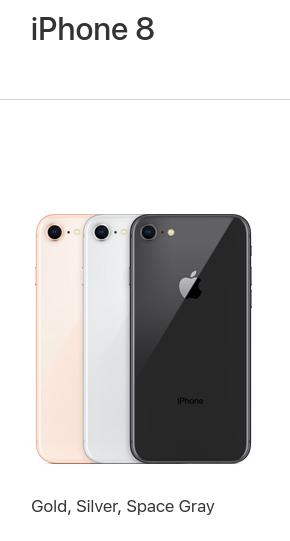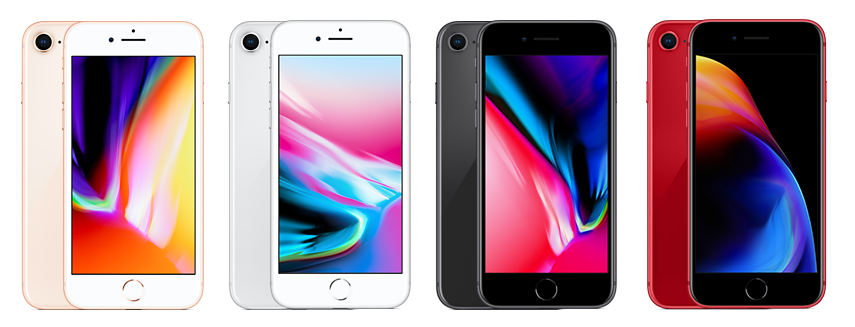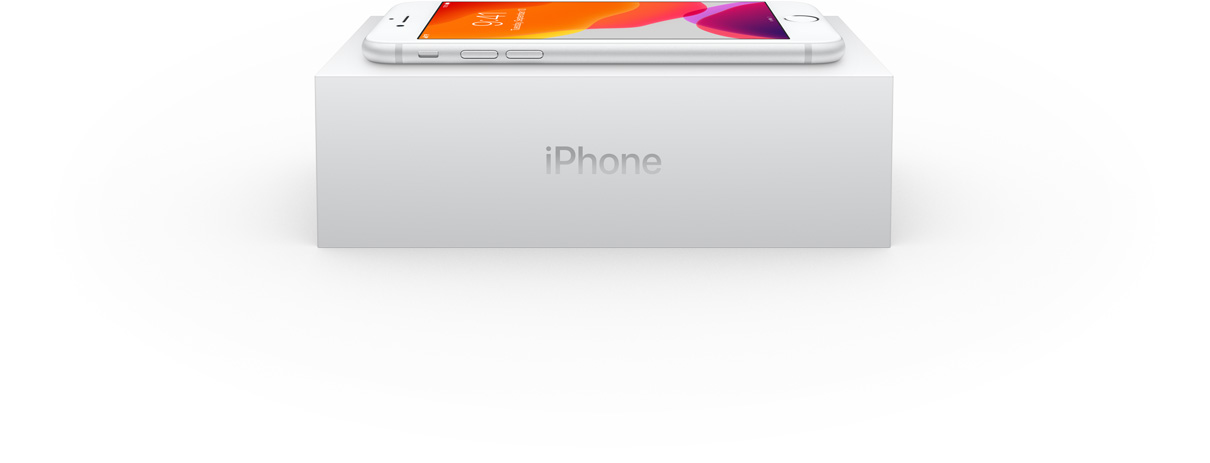Described as a “big stride forward for the iPhone” by Apple CEO, Tim Cook when it went on sale on September 12, 2017, the iPhone 8 and the iPhone 8 Plus were an improvement on everything we love about the iPhone.
In this review, we will explore the iPhone 8 specs and features as well as the iPhone 8 Price in Nigeria. So you’ll be able to decide if this smartphone is suitable for you.
The iPhone 8 combines elements of the iPhone X with those of the iPhone 7 and iPhone 7 Plus from a prior generation.
Although the iPhone 8 and iPhone 8 Plus have the same basic appearance as earlier models, they now have glass bodies sandwiched between matched aluminium frames. The iPhone 8 maintained its Touch ID Home button and substantial bezels at the top and bottom of the display, unlike the iPhone X.
See: How Much is iPhone XR in Nigeria
The iPhone 8, which is now available in three colours—Silver, Space Gray, and Gold—featured the strongest glass ever used in a smartphone in a reinforced steel and aluminium chassis that is IP67 water and dust resistant.
The device’s stereo speaker system has been improved to be 25% louder and has deeper bass.
In order to support a Qi-based inductive wireless charging feature, which enables the two handsets to be charged when put atop any Qi-certified inductive charger, Apple decided to make the iPhone 8 and iPhone 8 Plus’ bodies out of glass.
Also See: How Much is iPhone 7 Price in Nigeria
iPhone 8 Price in Nigeria 2023

The iPhone 8 price in Nigeria starts at NGN90,000 Naira to NGN270,000 Naira depending on the model, if its brand new or UK used as well as the vendor you’re buying from.
iPhone 8 Price in Nigeria UK Used
The iPhone 8 price in Nigeria UK Used starts from N660,000 to N735,000
| UK used Apple iPhone 8 Price in Nigeria (64GB) | N90,000 – N106,000 Naira |
| UK used Apple iPhone 8 Price in Nigeria (256GB) | N115,000 – N140,000 Naira |
How Much is iPhone 8 Plus in Nigeria on Konga
The iPhone 8 price in Nigeria on Konga starts at NGN127,000 Naira to NGN250,000 Naira depending on the model and the vendor you’re buying from.
| Apple iPhone 8 Price in Nigeria – Konga (64GB) | N127,000 – N140,000 Naira |
| Apple iPhone 8 Price in Nigeria – Konga (256GB) | N210,000 – N240,000 Naira |
How Much is iPhone 8 Price in Nigeria on Jumia
The iPhone 8 price in Nigeria on Jumia starts at NGN16,000 Naira to NGN165,000 Naira depending on the model and the vendor you’re buying from.
| Apple iPhone 8 Price in Nigeria – Jumia (64GB) | N130,000 – N170,000 Naira |
| Apple iPhone 8 Price in Nigeria – Jumia (256GB) | N210,000 – N250,000 Naira |
How Much is iPhone 8 Price in Nigeria on Slot
The iPhone price in Nigeria on Jumia starts at NGN120,000 Naira to NGN230,000 Naira depending on the model and the vendor you’re buying from.
| Apple iPhone 8 Price in Nigeria – Slot (64GB) | N120,000 – N160,000 Naira |
| Apple iPhone 8 Price in Nigeria – Slot (256GB) | N210,000 – N230,000 Naira |
Read Also: How Much is iPhone 14 Pro Max in Nigeria (UK Used & Slot)
iPhone 8 Design & Display

The iPhone 8 has a smaller 4.7-inch display. True Tone support was added to both screens, providing a more realistic, paper-like viewing experience by adjusting colour temperature and intensity to the ambient light in a space. There is still support for 3D Touch and P3 broad colour for a wider variety of colours.
The iPhone 8 has large bezels at the top and bottom of the smartphone and the same 4.7- and 5.5-inch display sizes as the iPhone 7 and iPhone 7 Plus from the front.
The front-facing camera, speaker, and related sensors are cut out at the top of the smartphone, while the capacitive “solid-state” Home button that simulates a button push is still there at the bottom of the device. The Home button has Touch ID.
Although the iPhone 8 may have a similar appearance to the iPhone 7 and iPhone 7 Plus, the glass shell is a key differentiator. The front and back glass is the most durable Apple has ever produced, the company claims. The two gadgets are available in Silver, Space Gray, and a new gold color that is somewhat rosier than other gold colors.
Apple added colour to the glass using a seven-layer printing process, giving the iPhone 8 and 8 Plus a vibrant depth of color. The oleophobic coating makes it simple to remove fingerprints and smudges.
Also See: How Much is Iphone 13 Pro Max in Nigeria
A stainless steel internal frame and an aerospace-grade 7000 Series aluminium band that matches the colour of each iPhone are used to hold the glass shell and display together for a seamless appearance. To provide a strong signal, tiny, practically undetectable antenna lines are carved through the metal frame.
The iPhone 8 has tough glass that is encased in a stainless steel internal frame, yet glass breaks when it hits the ground, and drop testing on the two handsets has shown that they are very breakable, even from waist-height drops.
The mute switch and volume buttons are located on the left side of the iPhone 8, while the sleep/wake button is located on the right side. Speaker holes and a Lightning port are located at the bottom. The two new gadgets, the iPhone 7 and iPhone 7 Plus lack a headphone connector and call for Lightning or Bluetooth headphones.
The iPhone 8 is a tiny bit bigger than the iPhone 7 and iPhone 7 Plus in terms of size. Although the size difference is so slight that it won’t actually be felt in use, it does exist.
The iPhone 8 has dimensions of 138.4mm in height, 67.3mm in width, and 7.3mm in thickness. The iPhone 7 measures 138.8mm tall, 67.1mm broad, and 7.1mm thick in comparison.
The iPhone 8 still has a protruding single-lens camera at the back, while the iPhone 8 Plus has a larger dual-lens rear camera set up horizontally.
Checkout: How Much is Iphone 12 Pro Max in Nigeria
The 4.7-inch screen on the iPhone 8 has a resolution of 1334 by 750 pixels, 326 pixels per inch, and a contrast ratio of 1400:1, while the 5.5-inch screen on the iPhone 8 Plus has a resolution of 1920 by 1080 pixels, 401 pixels per inch, and a contrast ratio of 1300:1.
The True Tone feature, which debuted in the iPad Pro, is new on the iPhone 8 and 8 Plus. For a more realistic viewing experience, True Tone employs the ambient light sensor to detect the illumination in space and adjusts the colour temperature and intensity to match the light.
For greater comfort and reduced eye strain, True Tone makes the iPhone’s display look more like paper when reading.
See: How Much is iPhone 6 Plus Price in Nigeria
Water Repellency
The iPhone 8 IS dust- and water-resistant, just like earlier iPhone models. The two devices have an IP67 dust/water resistance classification, which means they are completely dust-proof and can survive 1 meter (3.3 feet) of water for up to 30 minutes.
While the iPhone 8 can withstand splashes, rain, and brief accidental submersion, deliberate submersion should still be avoided. In addition, Apple’s warranty does not cover any type of water damage to an iOS device. Apple cautions that water and dust resistance are not always present and may diminish due to regular use.
iPhone 8 Token ID
The iPhone 8 and iPhone 8 Plus both have Touch ID functionality, making them a great option for customers not ready to give up fingerprint-based authentication in favour of the new facial recognition feature in the iPhone X. The iPhone X (which is being sold alongside the iPhone 8 and iPhone 8 Plus) lacks a Home button and, as a result, does not have Touch ID.
The second-generation Touch ID in the two devices is incredibly quick and precise. The iPhone can be unlocked, iTunes purchases can be verified, passcode-protected applications can be opened, and Apple Pay payments can be verified using Touch ID.
Also See: iPhone 14 Price in Nigeria: How Much is iPhone 14 price in Nigeria (Slot, UK Used & Jumia)
Iphone 8 Bionic Processor A11
The six-core A11 Bionic processor, which Apple said at launch was the smartest, most powerful CPU ever launched in a smartphone, is found within the iPhone 8 and iPhone 8 Plus. In comparison to the A10 Fusion chip in the iPhone 7, there are two performance cores that are 25% quicker and four efficiency cores that are 70% faster.
With a second-generation performance controller, all six cores may be utilized simultaneously for significantly faster multi-threaded task processing. An Apple-designed 3-core GPU with two Neural Engine cores performs machine learning tasks more quickly than ever before and is 30% quicker than the previous-generation GPU.
According to Apple, the A11 Bionic CPU in the iPhone 8 is the most potent and intelligent semiconductor ever put into a smartphone. It has a six-core CPU with two cores for high performance and four cores for great efficiency.
Both smartphones have 625 cd/m2 maximum brightness and support P3 wide colour for vibrant, true-to-life colours, just as the iPhone 7 and iPhone 7 Plus from a previous generation.
True Tone The True Tone feature, which debuted in the iPad Pro, is new in the iPhone 8. For a more realistic viewing experience, True Tone employs the ambient light sensor to detect the illumination in space and adjusts the colour temperature and intensity to match the light.
In comparison to the A10 processor in the iPhone 7, the two A11 cores are 25% quicker, while the four high-efficiency cores are 70% faster.
A second-generation performance controller enables simultaneous use of all four cores, improving multi-threaded workflow speed by 70%.
The A11 received an average single-core score of 4169 and an average multi-core score of 9836 in early Geekbench benchmarks. The A11 beats both the dual-core CPU in the 2017 13-inch MacBook Pro models and the A10X in the iPad Pro.
The A11 processor has a new three-core CPU that was created by Apple that is 30% faster than the GPU in the A10 chip, resulting in much better graphics performance. Additionally, a built-in M11 Motion coprocessor uses motion-based information from the gyroscope, accelerometer, and compass to power fitness applications, augmented reality experiences, and more without consuming a lot of power.
The Neural Engine, which is created to handle machine learning tasks, is made up of two efficiency cores.
Wireless Inductive Charging
A new addition to Apple’s iOS device portfolio, inductive wireless charging is made possible by the glass bodies of the iPhone 8.
The iPhone 8 may wirelessly charge with any Qi-certified charging adapter thanks to Apple’s adoption of the Qi open wireless charging standard used in many Android handsets.
Due to the inductive nature of Qi charging, the iPhone 8 must be put on a charging mat or comparable device in order to begin charging. Although physical contact is necessary, the wireless charging functionality usually functions.
The iPhone X, iPhone 8, and iPhone 8 Plus now allow quicker 7.5W wireless charging with third-party wireless chargers that are compatible with iOS 11.2. Before making a purchase, it is advisable to confirm that the wattage is indicated because not all wireless chargers can accommodate 7.5W.
Wireless charging is slower than other charging techniques, such as charging with the 12W iPad adapter and USB-C fast charging, but it is comparable to charging with the normal 5W iPhone charger in our tests, which contrasted multiple wired and wireless charging methods.
When utilizing compatible 7.5W chargers, 7.5W wireless charging is sometimes faster than 5W wireless charging, however, there are many variables that affect wireless charging speed, so the difference isn’t always obvious.
Wireless charging is practical and works well for overnight charging and circumstances when you don’t need a power boost right away.
A lot of wireless charging accessories are already on the market thanks to the Qi standard’s long availability, and manufacturers like Belkin and Mophie have created chargers expressly for Apple devices. If you’re looking for a wireless charger for an iPhone 8, you should check out our comprehensive roundup, which examines more than a dozen of current wireless chargers.
Airports, cafés, restaurants, coffee shops, and other sites all over the world have Qi charging capabilities. With Apple now supporting the standard, Qi charging outlets are expanding more quickly.
Many more recent automobiles have Qi-based chargers as well, and Apple has published a support document listing models with compatible chargers. The majority should function, however, the bigger iPhone 8 Plus may have size restrictions.
Iphone 8 Cameras
In comparison to the previous generation, the cameras in the iPhone 8 have superior sensors that permit 83 per cent more light into the wide-angle camera.
The A11 also features an updated picture signal processor that improves low-light performance, including quicker autofocus, as well as new pixel processing algorithms for pixel sharpness and texture.
Apple also introduced deeper pixels, a new colour filter, and hardware-enabled multi-band noise reduction for reduced noise, improved colour saturation, and a broader colour dynamic range.
A dual-lens camera system with an f/2.8 telephoto lens and an f/1.8 wide-angle lens, both of which have improved sensors, is still available on the bigger iPhone 8 Plus. The wide-angle lens in the iPhone 8 continues to support optical image stabilization.
Apple has upgraded its Portrait Lighting effect, which is only available with the dual-lens camera system on the iPhone 8 Plus, to dynamically alter an image’s lighting to resemble studio lighting methods.
Video capture on the iPhone 8 is better than ever thanks to the improved image signal processor and an Apple-designed video encoder that supports higher video frame rates and real-time picture and motion analysis. Both 4K footage at 60 frames per second and 1080p slow motion are supported.
The iPhone 8 was created by Apple with augmented reality in mind. The A11 Bionic provides world tracking and scenes while the GPU renders realistic graphics and the image signal processor provides real-time lighting estimation.
The cameras have been calibrated for augmented reality, and the gyroscope and accelerometer have been updated to enable more accurate motion tracking. Numerous new ARKit-based AR applications have been released with iOS 11, all of which may be used with an iPhone 8.
The 12-megapixel wide-angle f/1.8 camera in the iPhone 8 has a bigger, quicker sensor that lets in 83 per cent more light. A new colour filter, deeper pixels, a broader dynamic range of colour, and less noise in pictures and movies are other benefits.
Faster autofocus in low light, novel pixel processing methods for sharpness and texture, and hardware-enabled multi-band noise reduction are all features of a new picture signal processor built by Apple.
In order to enhance images before they are shot, the image signal processor also recognizes persons, motion, and lighting conditions in a scene.
Optical picture stabilization also enhances video and low-light photography.
A slow shutter speed and a strobe pulse are used with a quad-LED True Tone flash’s Slow Sync function to create a brighter foreground subject and appropriately lit background in dim situations. Additionally, the flash provides more even lighting for enhanced performance all around.
Video
The iPhone 8 reportedly supports the finest resolution video recording ever. Along with the new Apple-designed video encoder that enables faster video frame rates and real-time image and motion analysis that can anticipate changes in content to optimize video encoding algorithms, there is also an image signal processor that reduces noise and makes autofocus operate more quickly in low light.
As with 1080p video recording, 4K video recording may be done at 30, 24, or 60 frames per second.
Additionally available is 1080p slo-mo footage at 120 or 240 frames per second.
Camera on FaceTime
A 7-megapixel FaceTime HD camera with an f/2.2 aperture is located on the front of the iPhone 8 for selfies and FaceTime calls. Wide colour capture, auto picture stabilization, 1080p HD video recording, and Retina Flash that makes use of the display are all features of the camera.
Battery Life The iPhone 8 has a battery capacity of 1,821 mAh, which is less than the 1,960 mAh and 2,900 mAh batteries found in the iPhone 7 and iPhone 7 Plus, respectively. However, additional improvements have prevented any change in battery life.
Up to 14 hours of conversation time, 12 hours of internet use, 13 hours of video playing, and 40 hours of music playback are all possible on the iPhone 8.
The performance management functions of the iPhone 8, iPhone 8 Plus, and iPhone X may be less obvious since they employ a “different performance management mechanism” than earlier iPhone models.
In the future, the three smartphones may not require the same processor-throttling performance management capabilities featured in prior iPhones since they utilize a more sophisticated hardware and software architecture that is better equipped to anticipate power consumption and battery performance.
iPhone 8 Quick Charging
The iPhone 8 is “fast-charge capability,” which means that the battery life may be increased by 50% in just 30 minutes. Apple’s 29W, 61W, or 87W USB-C Power Adapters, available with its USB-C MacBook and MacBook Pro models, are required for fast charging the iPhone 8.
The USB-C Power Adapter must be purchased alongside a USB-C to Lightning cable, and the two products must cost at least $74.
iPhone 8 Artificial Reality
The A11 Bionic chip handles world tracking and sceneries while the GPU creates realistic visuals on the iPhone 8, which was created with augmented reality apps and games in mind. The cameras have been calibrated for augmented reality with support for 4K 60 fps and enhanced low light performance, while a new gyroscope and accelerometer enable more precise motion tracking. A new image signal processor handles real-time lighting estimates.
The vast array of augmented reality applications created with Apple’s ARKit and made available in iOS 11 is supported by all of these new features. The iPhone 8 offers an unmatched augmented reality experience, and ARKit turns the iPhone and iPad into the world’s largest AR platform.
Iphone 8 Features
iPhone 8 Speakers
Redesigned stereo speakers have richer bass and are up to 25% louder than the ones on the iPhone 7. The gadget has two speakers, one on top and one at the bottom.
iphone LTE
With LTE Advanced, the iPhone 8 can transport data at rates of up to 600Mb/s. The two gadgets are more likely to be compatible with networks in other countries when travelling because there are more than 20 LTE bands accessible.
Apple is employing both Intel and Qualcomm components, some of which are incompatible with the CDMA networks of Verizon and Sprint in the United States, much like with the iPhone 7 and iPhone 7 Plus from earlier this year.
Because they only support GSM networks, T-Mobile and AT&T’s iPhone 8 versions are incompatible with Verizon and Sprint. iPhone 8 variants from Verizon and Sprint. are compatible with T-Mobile and AT&T networks and support both GSM and CDMA networks.
While AT&T and T-Mobile employ Intel’s XMM 7480 modem, Verizon and Sprint smartphones look to use Qualcomm’s X16 Snapdragon gigabit-class modem. Both modems have improved performance, and it is likely that they were chosen for their increased power efficiency, which allowed Apple to reduce the size of the battery while keeping the same battery life.
While the Intel XMM 7480 delivers a peak theoretical speed of 600Mb/s and 4x carrier aggregation with two channels restricted to 10 MHz for overall bandwidth of 60 MHz, Qualcomm’s X16 modem supports gigabit-level peak theoretical rates and 4x carrier aggregation with a total bandwidth of up to 80 MHz.
Wi-Fi
The iPhone 8 is compatible with MIMO 802.11a/b/g/n/ac Wi-Fi. The connection rates may theoretically reach a maximum of 866Mb/s and use the same Wi-Fi technology as the iPhone 7 and 7 Plus.
NFC, Bluetooth, and GPS
The iPhone 8 comes with built-in support for the latest Bluetooth 5.0 standard. Compared to the Bluetooth 4.2 standard, Bluetooth 5.0 provides four times the range, twice the speed, and eight times the capacity for broadcast messages.
The iPhone 8 adds compatibility for Galileo, Europe’s Global Satellite Navigation System, and QZSS, the Quasi-Zenith Satellite System used in Japan, in addition to the Global Positioning System run by the American government.
Users of the new iPhones that have Galileo compatibility may take use of more accurate positioning that combines GPS, GLONASS, and Galileo signals.
Galileo features a cutting-edge signal structure that enables users to better keep their location fixed when traversing through urban areas throughout the world.
Regarding NFC, the iPhone 8 can read NFC tags put in locations such as retail establishments, museums, and more thanks to a new NFC chip with reader mode support.

